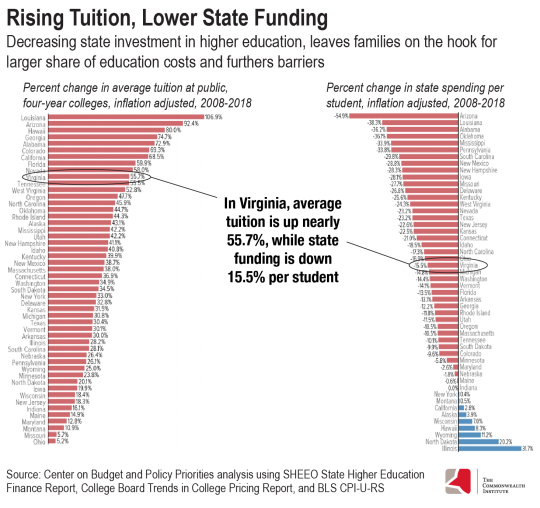October 31, 2019
Virginia Families Shoulder the Burden of Rising Higher Education Costs, Harming Students Facing Greatest Barriers
Tuition has increased dramatically at Virginia’s four-year colleges and universities, driven in part by deep state cuts in funding for higher education over the past decade. Students who already face the greatest economic and racial barriers to higher education are particularly impacted by these rising costs. And the pressure continues to mount. Recent news coverage indicates that the Northam administration has asked state colleges and universities to develop plans for further cuts. Rather than pursuing these harmful measures, state leaders should look to modernize our revenue system and fund a larger share of higher education costs to meet the state’s cost-sharing policy and increase investment in need-based financial aid.
A new report by the Center on Budget and Policy Priorities (CBPP) shows Virginia is one of 12 states where tuition at four-year public institutions has increased by more than 50% between 2008 and 2018, after adjusting for inflation. The average annual in-state tuition cost has increased 55.7%, equal to $4,587 more per student between 2008 and 2018. That’s well above the growth in tuition costs nationally of 37% or $2,708 during that same time period.
The dramatic rise in tuition is driven in part by deep reductions in state funding. Also shown in the CBPP report, Virginia decreased funding to public colleges and universities by 15.5% or $1,218 per student between 2008 and 2018, adjusting for inflation, despite improvements in the state economy and growing revenues during that time. These decreases were similar to the national average and have contributed to an increasing cost shift from the state to Virginia students and families.

Virginia’s undergraduate students on average now pay more than half (55%) of tuition costs and mandatory fees. Students should only be paying one-third of the cost (33%), if the state met its own cost-sharing policy, which was established in 2004 to moderate fluctuating tuition prices for students and families. The State Council of Higher Education for Virginia (SCHEV) estimates that tuition would be as much as $3,000 lower if state funding met this policy goal. A decrease in tuition of that size would offset almost two-thirds of the growth students have seen since 2008.
Rising tuition threatens affordability and access, leaving many students and their families saddled with onerous debt or unable to afford college altogether. U.S. households currently owe more in student loans than they do on credit cards or car loans, with the average undergraduate student in Virginia graduating with more than $30,000 in debt. This is especially true for students of color (who first started to gain access to some programs in Virginia’s white colleges and universities in the 1950s), low-income students, and students from non-traditional backgrounds. Alarmingly, the net price of attending a public college or university (i.e., tuition, room, board, and supplies less any financial aid) in Virginia was equal to one-quarter of the median income for households in 2017. And that amount equates to an even larger share for Latinx-headed households’ median income (27%) and for Black-headed households’ median income (36%).
Higher costs and decreasing access jeopardize not only the prospects of those individual students but also the outlook for whole communities, which increasingly rely on highly educated workforces to grow and thrive. Here in Virginia, full-time, year-round workers with a bachelor’s degree typically make $65,000 a year, compared to $35,000 for those without any education beyond a high school diploma or its equivalent. Not being able to access higher education in order to boost one’s income makes it harder for families with fewer resources to gain financial security.
Virginia lawmakers can address these cost barriers by increasing investments in its four-year colleges and universities to be more in line with its own cost-share policy. This step could go a long way to addressing growing tuition for all students, and they can take additional steps for students with the greatest economic barriers. For example, the state can build upon investments in the last budget to grow its need-based financial aid programs.
Virginia can also remove barriers by protecting and improving immigrants’ access to higher education. Currently, 21 states and D.C. provide more inclusive higher education policies by offering in-state tuition to residents regardless of immigration status. Virginia currently offers in-state tuition for immigrants who are enrolled in the Deferred Action for Childhood Arrivals (DACA) program, but with new enrollment in DACA frozen since September 2017, many current high schoolers never had a chance to enroll in DACA and thereby access in-state tuition when it comes time to apply for college. This coming legislative session, Virginia should learn from the success of other states and improve college affordability by offering in-state tuition for state residents, regardless of immigration status.
By making these changes, state leaders can dismantle barriers for every student in Virginia and allow students to consider all the options for their future.
Category:
Education
